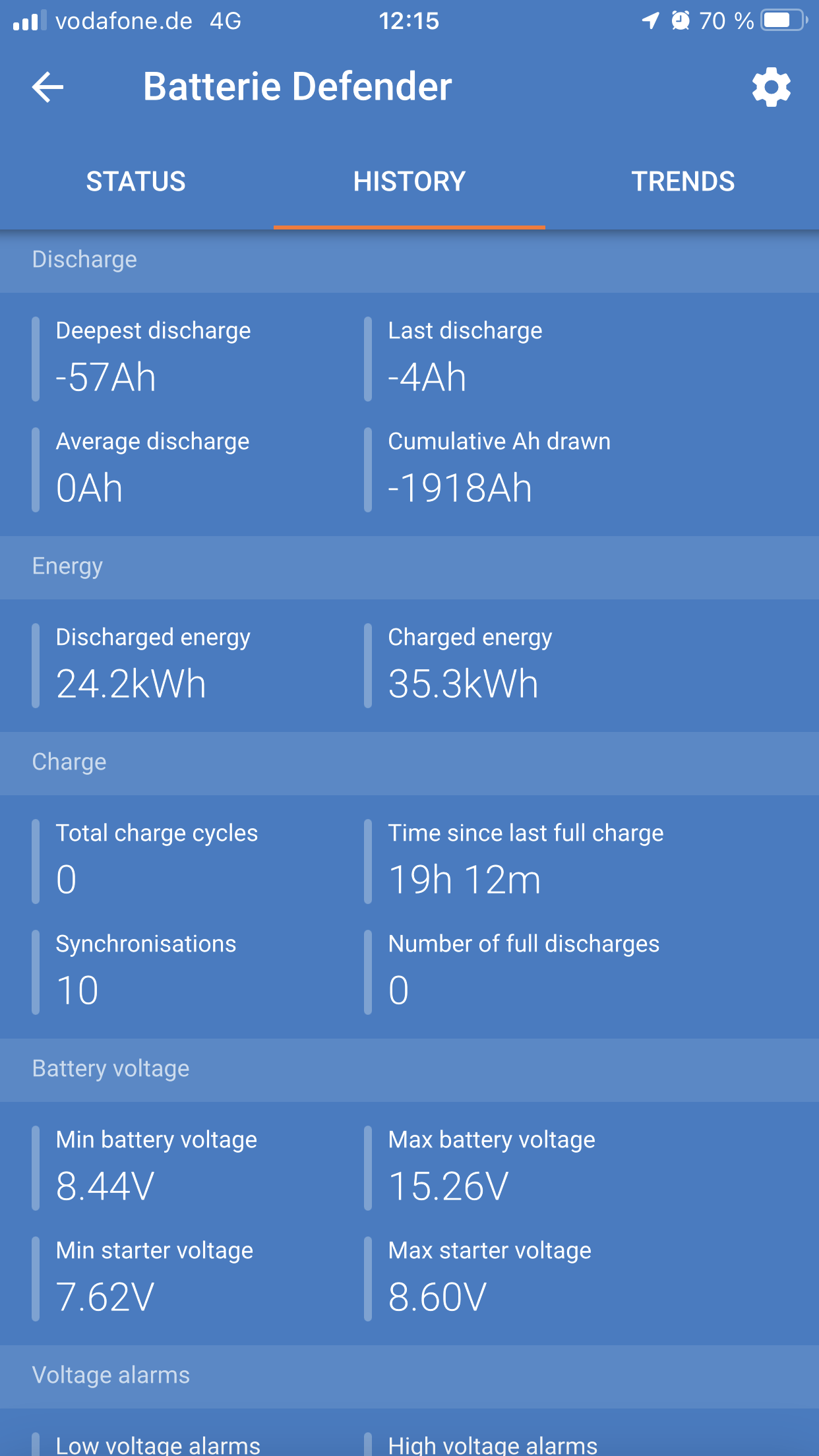How is this possible, the mismatch between discharged and charged energy? I (at least) think everything is connected correctly, and the shunt has been calibrated at zero charge.
Any tips? :) Thanks in advance!

How is this possible, the mismatch between discharged and charged energy? I (at least) think everything is connected correctly, and the shunt has been calibrated at zero charge.
Any tips? :) Thanks in advance!

Looks like it's a new system (or newly installed SmartShunt).
Presumably the battery was charged (with about 1.9kWh) when you first installed the SmartShunt.
I’ve the same behavior, I thought it’s connected to charge efficiency, in addition with floating etc…. You always put in more than you get out of a battery, this effect is stronger with led acid and agm batteries. But still exists with lithium.
Twice the charge energy might be a bit on the high side but as I said before, I get the same. But I didn’t question it further. Are you sure you have the shunt setup right?
Hi @Jan Martin Vagen @Kai Fuchs
Those kWh figures are as-measured, uncorrected. The only energy that may miss being reported is that below the Current Threshold setting.
Of course it's always possible the shunt is faulty, but it's far more likely that there's current bypassing the shunt somewhere. Might be just a little earth wire (emergency only use) bypassing the shunt, but that's where I'd be looking.
Is this a boat or vehicle and is there a hull or chassis connection to the battery negative because if there is then this needs moving to the system side of the shunt. This is often a source of errors on boats or vehicles.
It is worth repeating that you must only have on e cable connected to the battery negative and that goes to the shunt battery terminal. Every other negative cable goes to the system side of the shunt.
I my case it’s a car, and everything goes through the shunt. And I still have a deviation.

What you're seeing is the battery round-trip efficiency. This is mine over several years (~4?). Back to when Smartshunts first came out..

It equates to 79%, not great, but that's fla batts. Not very efficient if you don't draw them down much. Mine typically down to ~80% SOC overnight, and never to the 65% needed to register a cycle. There might also be a lot of mini-cycles involved with passing cloud. (The Ah are at ~48V)
Yours probably drawn down even less, so even less efficient. That may frighten you to the point of disbelief, but it's normal. Blame your batteries..
Mine's been running for a year or two since the last reset. Charge is about 20% higher than discharge. (215.5 cf 257.6).
I think there are a couple of factors...
Charge efficiency as already mentioned.
Current during float which will show up in the monitor as charge, but effectively is thrown away because the batteries are already fully charged.
It would be worth fully charging, then doing a reset of the monitor to see if the difference is still there. But as pointed out previously, it appears there's a drain bypassing the shunt. Do you have a ground on the battery for instance?
You did not tell us about your battery chemistry or capacity, I am assuming flooded lead acid.
Flooded lead acid batteries are notorious for being less efficient at higher SOCs. Check this out:
J. W. Stevens and G. P. Corey, "A study of lead-acid battery efficiency near top-of-charge and the impact on PV system design," Conference Record of the Twenty Fifth IEEE Photovoltaic Specialists Conference - 1996, Washington, DC, USA, 1996, pp. 1485-1488, doi: 10.1109/PVSC.1996.564417. Get it here: https://www.academia.edu/31588992/A_Study_of_Lead-Acid_Battery_Efficiency_Near_Top-of-Charge_and_the_Impact_on_PV_System_Design "Preliminary results agree we with established general understanding that the charge efficiency of flooded lead-antimony batteries declines with increasing state-of-charge, and that charge efficiency is a non-linear function of battery state-of-charge.These tests indicate that from zero SOC to 84% SOC the average overall battery charging efficiency is 91%, and that the incremental battery charging efficiency from 79% to 84% is only 55%."
Bear in mind they tested a particular model of a Rolls 12v battery as the conclusions are a bit draconian.
Myself I am running a 24v (12 x 2v) OPZS bank (the batteries being fairly new).
Looking into my data (SmartShunt) I have:

Overall, that's a ~75% charge/discharge efficiency (SOC hardly ever gets under 95%).
Your ratio (pic. on post 1 above, where 3.7Kwh out and 1.7Kwh in are recorded) does not seem right (also, values are too low; they may be daily and not representative). The point is: over time you ought to have more energy charged than discharged.
Just make sure you are not undercharging the batteries. As far as flooded lead batteries are concerned, I am afraid a SmartShunt won't ever fully replace regular readings from an old fashioned hydrometer.
52 People are following this question.